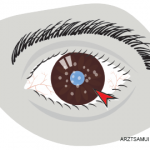Posterior uveitis is among the rarer forms of uveitis, but it is also the form of uveitis that can be most associated with loss of vision. The challenge with this condition is that visual symptoms may occur even in the absence of significant pain. Among the infections that can cause posterior uveitis are syphilis, toxoplasmosis, tuberculosis, endogenous endophthalmitis and viral causes, such as herpes simplex virus, herpes zoster virus and cytomegalovirus. Vision loss in posterior uveitis can occur quickly, and it may be necessary to rapidly escalate therapy to include one or more medications, such as methotrexate and/or mycophenolate mofetil.
Panuveitis is a generalized inflammation that includes the whole of the uveal tract, as well as the retina and vitreous humor. Dr. Kopplin said this particular form of uveitis can be seen in patients with sarcoidosis. Like the other forms of uveitis, infectious causes must be excluded, in particular with testing for syphilis and tuberculosis. Lyme testing may be indicated for patients with various forms of uveitis, although this depends on the geographic location of the patient (i.e., if it is a Lyme-endemic area). In Dr. Kopplin’s opinion, there is a limited role for testing for toxoplasma and toxocara in most patients with uveitis.
Several uveitis syndromes are restricted to the eye. These include sympathetic ophthalmia, birdshot retinopathy, serpiginous chorioretinopathy and pars planitis. Because many of these conditions may require use of systemic immunosuppressive treatments, it is important that rheumatologists be aware of them. Rheumatologists may be called upon to manage medications for these patients while collaborating with ophthalmologists.
Other Inflammatory Eye Diseases
Moving on to other forms of inflammatory eye disease, Dr. Kopplin explained that scleritis can be diagnosed with an exam using natural light alone. Patients with scleritis will often describe a “toothache-like” pain in the eye. There is often scleral injection with a purplish hue on exam, and scleritis is very frequently due to an underlying systemic inflammatory condition. Rheumatoid arthritis is a common culprit, but entities like hepatitis, IgG4-related disease and bisphosphonate-induced scleritis are possible as well.
Episcleritis is often self-limited and is not generally associated with a great deal of pain.
Dr. Kopplin also mentioned orbital inflammatory conditions, which may include dacryoadenitis, ocular myositis and inflammation of the orbital fatty tissue.
Across uveitis, scleritis and episcleritis, an underlying cause may not be found in a substantial number of patients, and the condition is then regarded as idiopathic.


